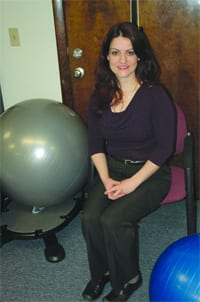Creating a Game Plan Physical Therapist Says Education and Action are Keys to Maintaining Physical Health
Sofia Zanzarella may treat a number of athletes through her physical therapy practice, but she has some fans of her own.
One is Steve Burrell, a retired military serviceman who, following his retirement, decided to buy a motorcycle and sow some wild oats.
“I promptly had an accident,” said Burrell with some chagrin, adding that he severely damaged his left shoulder in the mishap.
He visited Zanzarella, who has been a practicing physical therapist for 10 years. During that time, she has worked with a number of professional athletes, but has also helped a number of non-athletes as well — people like Burrell, who said he has regained about 90{06cf2b9696b159f874511d23dbc893eb1ac83014175ed30550cfff22781411e5} mobility in his shoulder, and credits Zanzarella with that progress.
“I even play tennis,” he said.
Zanzarella said stories like Burrell’s are the kind of good news that all physical therapists need to build awareness and acceptance of the field as not only an answer to treating injuries, but also as an ongoing, preventative measure for all types of people experiencing pain or limited mobility because of physical injuries or pain caused by repetitive patterns.
She received her degree from Andrews University in Michigan and since then has worked in a number of capacities, including at the corporate level for a major outpatient clinic in the area.
However, due in part to her specific professional interests, Zanzarella decided to open her own private practice in 2004, and now leads Rehab Resolutions in West Springfield.
Since the clinic opened, growth has been steady; Zanzarella recently opened a second location in Westfield and is looking toward expanding her staff in the next year to keep up with patient demand. She cited several reasons for her continued success, including a growing acceptance of physical therapy as both treatment for injuries and as a preventative measure, particularly among athletes. She also listed some of her preferred therapies – manual work such as active release techniques (ART®), a soft tissue management system developed by chiropractor P. Michael Leahy that treats problems, such as nerves or blood vessels that have been trapped by injured or healing muscles, and may not respond to other traditional treatments.
“ART was used on me but in addition, Sofia created an entire exercise and stretching regiment for me, and was attentive in making certain I followed it,” said Burrell.
Zanzarella said the combination of manual work with exercises and stretches can make for better outcomes.
“It makes patients feel like we’re doing something substantial to help them ,” she said. “And manual therapy can jump-start outcomes in patients, as far as treating and resolving issues.”
Rules of Play
Many of Zanzarella’s patients are athletes of all ages, and are focused on the best treatments to not only resolve existing issues, but also on preventing injuries that could inhibit their ability.
“Everyone heals on their own to a certain extent, but PT can help you heal faster and better,” she said. “The use of PT is gaining acceptance among many trainers and coaches, but also among pediatricians as well.”
This underscores the importance of physical therapy in terms of treating and preventing injuries that can seriously effect an athlete’s performance, she said, because there is an overriding mentality among athletes that unless a bone is broken, it’s acceptable to ‘play through the pain.’
“It’s part of a physical therapist’s professional responsibility to educate the public on how full, comprehensive treatments can manage symptoms and prevent new injuries from occurring,” she said. “Athletes, especially young athletes, recover well, but physical therapy ensures that things are healing properly and aligning correctly as they heal.”
That becomes doubly important, Zanzarella said, in the case of high school and college athletes who often play more than one sport throughout the year. Different injuries are common to different sports, and without addressing each issue as it occurs, injuries can sometimes layer on top of each other and compound problems.
Hockey players, for instance, often experience injuries of the knee and back, while softball players are prone to problems in the ankles and shoulders. Weaknesses encountered during one season of play, said Zanzarella, can often make new injuries more likely.
“Sometimes you have to fish around to see the whole picture,” she said, “but if old injuries aren’t addressed, those weaknesses can lead to new problems.”
Leveling the Playing Field
And that’s not a phenomenon that is limited to athletes, she added, nor is the notion of ‘playing through the pain.’
It’s common, she said, for people with a wide range of injuries or chronic pain caused by sprains, strains, broken bones, or syndromes such as carpal tunnel, to modify their behavior to avoid or manage pain in their own way. Frequently, she noted, people don’t even realize that they’ve significantly changed their patterns of activity, and therefore the option of physical therapy isn’t mulled as soon as it perhaps should be.
“People accommodate their lifestyles to pain, and they’re unaware that they’re doing it,” she said. “There might be a loss of function or a loss of motion that stops someone from putting groceries in a top cupboard or from taking the stairs … these are things people will do without even thinking about it.
“It goes back to that education piece,” she said, “and spreading the word that physical therapy doesn’t have to be limited to right after a specific injury occurs. Any pain that lasts more than two to three weeks should be addressed, even if it comes and goes.”
Wheels in Motion
The only thing coming and going in Burrell’s life, however, is himself; he told The Healthcare News that he recently took his motorcycle out of the garage and re-licensed it for the spring and summer season.
“I am back on the bike,” he said. “Motorcycling is one of my great passions. I’ve been given a gift.”





Comments are closed.